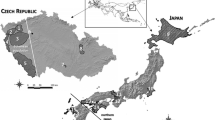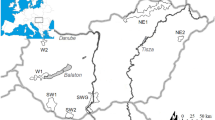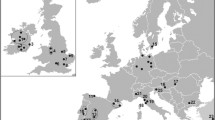Abstract
Since the 1980s, the sika deer (Cervus nippon Temminck, 1838) population of Hokkaido, Japan, has grown, resulting in range expansion. To assess the effects of this range expansion on the spatial genetic structure of the population, we compared subpopulation structures during 2 different periods (168 samples for 1991–1996, and 169 samples for 2008–2010), using mitochondrial DNA (mtDNA; D-loop) and microsatellites (9 loci). The number of gene-based subpopulations decreased across the 15-year period; specifically from four to three subpopulations based on mtDNA, and from two to one subpopulation based on microsatellite DNA. The fusion of the two northern subpopulations caused the change to the mtDNA-based structure, which might be explained by the dispersal of females from higher to lower density subpopulations. In comparison, the reason for the change in the microsatellite DNA-based structure was unclear, because no significant genetic differentiation was observed between the two study periods. A stable mtDNA-based structure was maintained in the north and central population separated by a west-to-east boundary, while a north-to-south boundary in eastern Hokkaido maintained stability in the eastern subpopulation versus all other subpopulations. The findings of this study demonstrate the importance of understanding gene flow within a structured population to implement effective management efforts; for instance, the culling of one subpopulation might not affect an adjacent subpopulation, because deer movement is limited between the subpopulations.





Similar content being viewed by others
References
Avise JC (2004) Molecular markers, natural history, and evolution, 2nd edn. Sinauer Associates Inc, Sunderland
Beja-Pereira A, Zeyl E, Ouragh L, Nagash H, Ferrand N, Taberlet P, Luikart G (2004) Twenty polymorphic microsatellites in two of North Africa’s most threatened ungulates: Gazella dorcas and Ammotragus lervia (Bovidae; Artiodactyla). Mol Ecol Notes 4:452–455
Bishop MD, Kappes SM, Keele JW, Stone RT, Sunden SLF, Hawkins GA, Toldo SS, Fries R, Grosz MD, Yoo JY, Beattie CW (1994) A genetic-linkage map for cattle. Genetics 136:619–639
Brown TL, Decker DJ, Riley SJ, Enck JW, Lauber TB, Curtis PD, Mattfeld GF (2000) The future of hunting as a mechanism to control white-tailed deer populations. Wildl Soc B 28:797–807
Clutton-Brock TH, Coulson TN, Milner-Gulland EJ, Thomson D, Armstrong HM (2002) Sex differences in emigration and mortality affect optimal management of deer populations. Nature 415:633–637
Côté SD, Rooney TP, Tremblay JP, Dussault C, Waller DM (2004) Ecological impacts of deer overabundance. Annu Rev Ecol Evol Syst 35:113–147
Coulon A, Guillot G, Cosson JF, Angibault JMA, Aulagnier S, Cargnelutti B, Galan M, Hewison AJM (2006) Genetic structure is influenced by landscape features: empirical evidence from a roe deer population. Mol Ecol 15:1669–1679
Crandall KA, Bininda-Emonds ORP, Mace GM, Wayne RK (2000) Considering evolutionary processes in conservation biology. Trends Ecol Evol 15:290–295
Department of Fishery and Forestry, Hokkaido (1990–2010) Statistics of forestry in Hokkaido. Department of Fishery and Forestry, Hokkaido (in Japanese)
Dewoody JA, Honeycutt RL, Skow LC (1995) Microsatellite markers in white-tailed deer. J Hered 86:317–319
DeYoung RW, Demarais S, Honeycutt RL, Rooney AP, Gonzales RA, Gee KL (2003) Genetic consequences of white-tailed deer (Odocoileus virginianus) restoration in Mississippi. Mol Ecol 12:3237–3252
Escos J, Alados CL, Emlen JM (1994) Application of the stage-projection model with density-dependent fecundity to the population-dynamics of Spanish Ibex. Can J Zool 72:731–737
Excoffier L, Lischer HEL (2010) Arlequin suite ver 3.5: a new series of programs to perform population genetics analyses under Linux and Windows. Mol Ecol Resour 10:564–567
Falush D, Stephens M, Pritchard JK (2003) Inference of population structure using multilocus genotype data: linked loci and correlated allele frequencies. Genetics 164:1567–1587
Frantz AC, Bertouille S, Eloy MC, Licoppe A, Chaumont F, Flamand MC (2012) Comparative landscape genetic analyses show a Belgian motorway to be a gene flow barrier for red deer (Cervus elaphus), but not wild boars (Sus scrofa). Mol Ecol 21:3445–3457
Fuller RJ, Gill RMA (2001) Ecological impacts of increasing numbers of deer in British woodland. Forestry 74:193–199
Greenwood PJ (1980) Mating systems, philopatry and dispersal in birds and mammals. Anim Behav 28:1140–1162
Guillot G, Mortier F, Estoup A (2005) GENELAND: a computer package for landscape genetics. Mol Ecol Notes 5:712–715
Igota H, Sakuragi M, Uno H, Kaji K, Kaneko M, Akamatsu R, Maekawa K (2004) Seasonal migration patterns of female sika deer in eastern Hokkaido, Japan. Ecol Res 19:169–178
Imaizumi Y (1949) The natural history of Japanese mammals. Yoyoshobo, Tokyo (in Japanese)
Inukai T (1952) The sika deer of Hokkaido and its prosperity and decline. Hoppo Bunka Kenkyu Houkoku (The Report of Northern Cultural Research) 7:1–45 (in Japanese)
Ishibashi Y, Saitoh T (2004) Phylogenetic relationships among fragmented Asian black bear (Ursus thibetanus) populations in western Japan. Conserv Genet 5:311–323
Kaji K, Miyaki M, Saitoh T, Ono S, Kaneko M (2000) Spatial distribution of an expanding sika deer population on Hokkaido Island, Japan. Wildlife Soc B 28:699–707
Kaji K, Saitoh T, Uno H, Matsuda H, Yamamura K (2010) Adaptive management of sika deer populations in Hokkaido, Japan: theory and practice. Popul Ecol 52:373–387
Kocher TD, Thomas WK, Meyer A, Edwards SV, Pääbo S, Villablanca FX, Wilson AC (1989) Dynamics of mitochondrial-DNA evolution in animals—amplification and sequencing with conserved primers. Proc Natl Acad Sci USA 86:6196–6200
Librado P, Rozas J (2009) DnaSP v5: a software for comprehensive analysis of DNA polymorphism data. Bioinformatics 25:1451–1452
Manel S, Bellemain E, Swenson JE, Francois O (2004) Assumed and inferred spatial structure of populations: the Scandinavian brown bears revisited. Mol Ecol 13:1327–1331
McShea WJ, Monfort SL, Hakim S, Kirkpatrick J, Liu I, Turner JW, Chassy L, Munson L (1997) The effect of immunocontraception on the behavior and reproduction of white-tailed deer. J Wildl Manage 61:560–569
Mezzelani A, Zhang Y, Redaelli L, Castiglioni B, Leone P, Williams JL, Toldo SS, Wigger G, Fries R, Ferretti L (1995) Chromosomal localization and molecular characterization of 53 cosmid-derived bovine microsatellites. Mamm Genome 6:629–635
Moritz C (2002) Strategies to protect biological diversity and the evolutionary processes that sustain it. Syst Biol 51:238–254
Mysterud A, Yoccoz NG, Stenseth NC, Langvatn R (2000) Relationships between sex ratio, climate and density in red deer: the importance of spatial scale. J Anim Ecol 69:959–974
Nagata J, Masuda R, Kaji K, Kaneko M, Yoshida MC (1998) Genetic variation and population structure of the Japanese sika deer (Cervus nippon) in Hokkaido Island, based on mitochondrial D-loop sequences. Mol Ecol 7:871–877
Nei M, Tajima F (1987) Problems arising in phylogenetic inference from restriction-site data. Mol Biol Evol 4:320–323
Nelson ME (1993) Natal dispersal and gene flow in white-tailed deer in northeastern Minnesota. J Mammal 74:316–322
Nielsen EK, Olesen CR, Pertoldi C, Gravlund P, Barker JSF, Mucci N, Randi E, Loeschcke V (2008) Genetic structure of the Danish red deer (Cervus elaphus). Biol J Linn Soc 95:688–701
Ohtaishi N (1986) Preliminary memorandum of classification, distribution and geographic variation on sika deer. Mamm Sci 53:13–17 (in Japanese)
Park SDE (2001) Trypanotolerance in west African cattle and the population genetic effects of selection. Ph.D. thesis, University of Dublin
Peery MZ, Kirby R, Reid BN, Stoelting R, Doucet-Beer E, Robinson S, Vasquez-Carrillo C, Pauli JN, Palsboll PJ (2012) Reliability of genetic bottleneck tests for detecting recent population declines. Mol Ecol 21:3403–3418
Pérez-Espona S, Pérez-Barberia FJ, Mcleod JE, Jiggins CD, Gordon IJ, Pemberton JM (2008) Landscape features affect gene flow of Scottish Highland red deer (Cervus elaphus). Mol Ecol 17:981–996
Pérez-González J, Frantz AC, Torres-Porras J, Castillo L, Carranza J (2012) Population structure, habitat features and genetic structure of managed red deer populations. Eur J Wildl Res 58:933–943
Rousset F (2008) GENEPOP’007: a complete re-implementation of the GENEPOP software for Windows and Linux. Mol Ecol Resour 8:103–106
Rueness EK, Jorde PE, Hellborg L, Stenseth NC, Ellegren H, Jakobsen KS (2003) Cryptic population structure in a large, mobile mammalian predator: the Scandinavian lynx. Mol Ecol 12:2623–2633
Saitoh T, Ishibashi Y, Kanamori H, Kitahara E (2001) Genetic status of fragmented populations of the Asian black bear Ursus thibetanus in western Japan. Popul Ecol 43:221–227
Schwartz MK, Luikart G, Waples RS (2007) Genetic monitoring as a promising tool for conservation and management. Trends Ecol Evol 22:25–33
Slate J, Coltman DW, Goodman SJ, MacLean I, Pemberton JM, Williams JL (1998) Bovine microsatellite loci are highly conserved in red deer (Cervus elaphus), sika deer (Cervus nippon) and Soay sheep (Ovis aries). Anim Genet 29:307–315
Slatkin M (1987) Gene flow and the geographic structure of natural populations. Science 236:787–792
Staines BW (1977) Factors affecting seasonal distribution of red deer (Cervus elaphus) at Glen-Dye, northeast Scotland. Ann Appl Biol 87:495–512
Stenseth NC, Bjørnstad ON, Saitoh T (1998) Seasonal forcing on the dynamics of Clethrionomys rufocanus: modeling geographic gradients in population dynamics. Res Popul Ecol 40:85–95
Talbot J, Haigh J, Plante Y (1996) A parentage evaluation test in North American Elk (Wapiti) using microsatellites of ovine and bovine origin. Anim Genet 27:117–119
Tamura K, Dudley J, Nei M, Kumar S (2007) MEGA4: molecular evolutionary genetics analysis (MEGA) software version 4.0. Mol Biol Evol 24:1596–1599
Terada C, Tatsuzawa S, Saitoh T (2012) Ecological correlates and determinants in the geographical variation of deer morphology. Oecologia 169:981–994
Terada C, Yamada T, Uno H, Saitoh T (2013) New mtDNA haplotypes of the sika deer (Cervus nippon) found in Hokkaido, Japan suggest human-mediated immigration. Mamm Study 38:123–129
The Geneland development group (2012) Population genetic and morphometric data analysis using R and the Geneland program. http://www2.imm.dtu.dk/~gigu/Geneland/
Uno H (2006) Population ecology and management for the sika deer in eastern Hokkaido, Japan. DC thesis, Hokkaido University
Uno H, Kaji K, Saitoh T, Matsuda H, Hirakawa H, Yamamura K, Tamada K (2006) Evaluation of relative density indices for sika deer in eastern Hokkaido, Japan. Ecol Res 21:624–632
Vaiman D, Mercier D, Moazamigoudarzi K, Eggen A, Ciampolini R, Lepingle A, Velmala R, Kaukinen J, Varvio SL, Martin P, Leveziel H, Guerin G (1994) A set of 99 cattle microsatellites—characterization, synteny mapping, and polymorphism. Mamm Genome 5:288–297
van Oosterhout C, Hutchinson WF, Wills DPM, Shipley P (2004) MICRO-CHECKER: software for identifying and correcting genotyping errors in microsatellite data. Mol Ecol Notes 4:535–538
Walsh NE, Griffith B, Mccabe TR (1995) Evaluating growth of the Porcupine caribou herd using a stochastic-model. J Wildl Manage 59:262–272
Ward AI, White PCL, Walker NJ, Critchley CH (2008) Conifer leader browsing by roe deer in English upland forests: effects of deer density and understory vegetation. Forest Ecol Manage 256:1333–1338
Warren RJ (2011) Deer overabundance in the USA: recent advances in population control. Anim Prod Sci 51:259–266
Weir BS, Cockerham CC (1984) Estimating F-statistics for the analysis of population structure. Evolution 38:1358–1370
Whitehead GK (1993) The encyclopedia of deer. Swann-Hill, Shrewsbury
Zannèse A, Morellet N, Targhetta C, Coulon A, Fuser S, Hewison AJM, Ramanzin M (2006) Spatial structure of roe deer populations: towards defining management units at a landscape scale. J Appl Ecol 43:1087–1097
Acknowledgments
We thank the Hokkaido government and the Hokkaido Hunters Association for helping with sample collection. We are also indebted to the editors and anonymous reviewers for improving the manuscript. This work was supported by The Mitsui & Co., Ltd. Environment Fund and by JSPS Grant-in-Aid for Scientific Research (2238008712) to HU.
Author information
Authors and Affiliations
Corresponding author
Rights and permissions
About this article
Cite this article
Ou, W., Takekawa, S., Yamada, T. et al. Temporal change in the spatial genetic structure of a sika deer population with an expanding distribution range over a 15-year period. Popul Ecol 56, 311–325 (2014). https://doi.org/10.1007/s10144-013-0425-y
Received:
Accepted:
Published:
Issue Date:
DOI: https://doi.org/10.1007/s10144-013-0425-y




